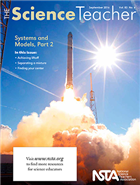Focus on Physics: When Our Round Earth Was First Measured
By sstuckey
Posted on 2016-09-08
Building an Understanding of Physical Principles
Our Earth is round, although it was not always thought to be that way. It looks flat. But if the Earth is viewed from a tall building, especially near the ocean when the horizon is clear, its curvature can be seen with the naked eye. This is helped with the aid of a straightedge held

Figure 1. From a high elevation, a straightedge held at arm’s length shows that the horizon is not quite level but curved.
at arm’s length aligned with the horizon (Figure 1), a popular activity of residents of tall high-rises near the seashore.
Eratosthenes’ observations
The first person credited with measuring the roundness of Earth was the Greek scholar and geographer Eratosthenes of Cyrene in 235 BC. This man of learning was the chief librarian at the Library of Alexandria in Egypt. Just as the Sun and Moon are round, Eratosthenes assumed Earth was also round. He proceeded to measure “how round” and more.
From library information, Eratosthenes learned that the Sun is directly overhead at the summer solstice in the southern city of Syene (now called Aswan). At this special time in June, sunlight shining straight down a deep well in Syene was reflected up again—the only time the Sun’s reflection could be seen in the well. A nearby vertical stick in the ground at this time would cast no shadow, but farther north, in Alexandria, a vertical stick would cast a shadow.
This was evident to Eratosthenes, who noted the shadow cast by a tall, vertical pillar near his library during the summer solstice (Figure 2).
He measured the shadow, the shortest shadow of the year, to be 1/8 the height of the vertical pillar.
Eratosthenes’ calculations
Eratosthenes correctly assumed that rays from the faraway Sun are parallel. He then learned that while these parallel rays were vertical in Syene, they were nonvertical in Alexandria. Furthermore, he reasoned that if a line along the vertical well in Syene were extended into Earth, it would pass through Earth’s center. Likewise for a vertical line in Alexandria (or any point on the spherical Earth).
His knowledge of geometry told him that if the verticals at both locations were extended to the center of Earth, they would form the same angle that the Sun’s rays make with the pillar at Alexandria. Knowing the 8:1 ratio of the pillar’s height to the shadow length, Eratosthenes could calculate these angles to be 7.1° (Figure 3). Most

Figure 3. The 7.1° angle between the Sun’s rays and the pillar at Alexandria is the same 7.1° angle between the verticals from Alexandria and Syene.
importantly, 7.1° is about 1/50 of a circle (360 / 7.1 ≈ 50). Imagine Earth divided into 50 triangles, each with a 7.1° angle at Earth’s center and the angle’s opposite side equal to the distance between the two cities.
Aha! Eratosthenes reasoned that the distance between Alexandria and Syene must be 1/50 of Earth’s circumference! Thus the circumference of Earth becomes 50 times the distance between these two cities. This distance, quite flat and frequently traveled, was measured by surveyors to be about 5,000 stadia (800 kilometers today). Using this measurement, Earth’s circumference is 50 × 800 kilometers = 40,000 kilometers, which is very close to today’s accepted value.
Another line of reasoning that bypasses the 7.1° measurement is indicated by the nearly similar triangles in Figure 4. Just as the pillar is 8 times as high as the length of its shadow, the radius of Earth must

Figure 4. Similar triangles. Sides a and b have the same ratio as sides A and B. Just as the pillar’s height b is eight times the length of its shadow, Earth’s radius is eight times the distance between the two cities.
be 8 times the distance between the two cities. That is, Earth’s radius is 8 × 800 kilometers = 6,400 kilometers, very close to the currently accepted value. Once the value of the radius is known, the circumference is easily calculated (C = 2πr).
Eratosthenes’ legacy
Today, Eratosthenes is primarily remembered for his amazing calculation of Earth’s size, using only good thinking and a bit of geometry. Seventeen hundred years after Eratosthenes’ death, Christopher Columbus studied Eratosthenes’ findings before setting sail. Rather than heed them, however, Columbus chose to accept more up-to-date maps that indicated Earth’s circumference to be one-third smaller. If Columbus had accepted Eratosthenes’ larger circumference, then he would have known that the land he discovered was not the East Indies but rather a new world. ■
Paul G. Hewitt (pghewitt@aol.com) is the author of the popular textbook Conceptual Physics, 12th edition, and coauthor with his daughter Leslie and nephew John Suchocki of Conceptual Physical Science, 6th edition.
On the web
See complementary tutorial screencasts on physics by the author at www.HewittDrewit.com and on physical science and astronomy at www.ConceptualAcademy.com.
Editor’s Note
This article was originally published in the September 2016 issue of The Science Teacher journal from the National Science Teachers Association (NSTA).
Join NSTA today
and receive The Science Teacher, the peer-reviewed journal just for high school teachers; to write for the journal, see our Author Guidelines and Call for Papers; connect on the high school level science teaching list (members can sign up on the list server); or consider joining your peers at future NSTA conferences.
The mission of NSTA is to promote excellence and innovation in science teaching and learning for all.
Disclaimer: The views expressed in this blog post are those of the author(s) and do not necessarily reflect the official position of the National Science Teaching Association (NSTA).




